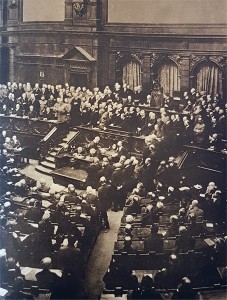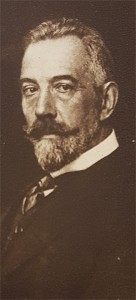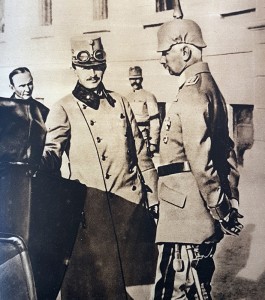 |
 |
Speech by Bethmann Hollweg to the Reichstag (German Parliament) before the deputies on 12 December 1916, during which he proposed, on behalf of the Central Empires (Germany, Austria-Hungary, Ottoman, Bulgaria), the start of peace negotiations. The Chancellor was at the time supported by Emperor Guillaume II. The Allies rejected the request on 30 December 1916. On the left, photograph published in Le Miroir. The commentary to the images tells how the Chancellor reported on the military and political situation by emphasising the advances made by the central powers. He then discusses the official entreaties made to the neutral countries with a view toward peace, and reads the Allies’ response. On the right, portrait of Theobald von Bethmann Hollweg published in Le Miroir.
 Le Miroir January 14 1917 : Emperor of Austria-Hungary Charles I and Falkenenhayn in Kronstadt, Romania. © Paris, musée de l’Armée
Le Miroir January 14 1917 : Emperor of Austria-Hungary Charles I and Falkenenhayn in Kronstadt, Romania. © Paris, musée de l’Armée
Woodrow Wilson announces to the US Congress the break with Germany in February 1917. Le Miroir, Sunday February 18 1917. © Paris, musée de l’Armée
“An additional prophecy on the date of peace has just come to light in England. It is very fashionable with our friends and proves at least as fashionable with us — isn’t that already quite a great deal? What confident admiration the English have for their leader. Take each letter from Haig’s name, denote their place in the alphabet with a number, and you will find the following combination: H = 8th letter, A = 4th letter, I = 9th letter, G = 7th letter, i.e. 8197, which, reversed, results in 7918. The war will therefore end on 7/9 1918, i.e. on 7 September of the coming year,” wrote Le Figaro on 6 November 1917.
Attempts to find peace
To achieve peace, a covenant is needed, a contract of sorts, which reflects an agreement of will between two or more parties. Different phases must be crossed: negotiations in which the States are represented by plenipotentiaries; the adoption of a text by the delegates of the States; the authentication by the States, which declare that this is, or is not, the negotiated text; the signature of the text, generally by a minister; ratification, through which the commitments made are confirmed, at the level of executive power, by the Head of State, the Head of Government or an official person authorised with consent of the Parliament.
Peace… On condition
Already in 1916, several negotiations, more or less secret, were initiated by various camps to end the war and bring about peace. However, each stuck firmly to their positions or made other attempts fail. Here are some of those attempts.
1916
In November 1916, the German Chancellor, Bethmann Hollweg, sent Ambassador von Bernstorff to the United States to sound out the ground for a possible peace conference. That same month, Emperor-King Charles I (Austrian Emperor from 22 November 1916 to 12 November 1918), made peace proposals to the Allies through his brother-in-law, Princes Sixte and François-Xavier of Bourbon-Parma, who were then officers in the Belgian Army. On December 12, Bethmann Hollweg made mention in the Reichstag the attempt to negotiate peace with the Allies through neutral countries (see illustration above). On 18 December, W. Wilson, President of the United States, sent a note to all the belligerents: he wanted to mediate between them and asked them to specify their aims in war. On 30 December, the Allies refused the negotiations proposed by the Germans, which they considered a war manoeuvre and not an entreaty for peace.



Ajouter un commentaire